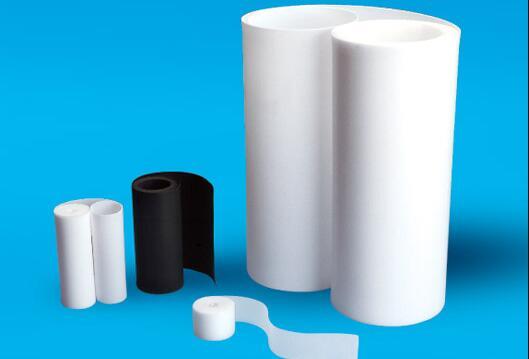Skived PTFE Tape is made with polymer™ fluoroplastic and a pressure sensitive silicone adhesive on one side. Skived PTFE tape is highly conformable with 300% elongation. PTFE tape features superior insulating strength, is non-stick, flexible, high temperature, as well as chemical, heat & moisture resistant. Other properties include no porosity, excellent release, and of course it has a super-low coefficient of friction. Also used as an insulating and masking tape.

Skived PTFE (Polytetrafluoroethylene) film is sold by the pound, ft, or meter in slit width or full width rolls and can also be supplied in sheet form. It is used in electrical applications where high temperature service rating and superior electrical properties are desired. Examples of electrical applications include capacitor films, harnesses for electrical wiring in automotive and aerospace applications, spacers for transformers and other electrical insulation applications where high dielectric strength and high temperature resistance are requisite.
What is Skiving ?
Skiving or scarfing machines cut material off in slices, usually metal, but also leather or laminates. The process is used instead of rolling the material to shape when the material must not be work hardened, or must not shed minute slivers of metal later which is common in cold rolling processes.
The skiving process, meaning “to slice”, can be applied to a variety of applications and materials. In leather, skiving knives trim the thickness of the leather, often around the edges, to thin the material and make it easier to work with. In metal working, skiving can be used to remove a thin dimension of material or to create thin slices in an existing material, such as heat sinks where a large amount of surface area is required relative to the volume of the piece of metal.
The process involves moving the strip past precision-profiled slotted tools made to an exact shape, or past plain cutting tools. The tools are all usually made of tungsten carbide-based compounds. In early machines, it was necessary to precisely position the strip relative to the cutting tools, but newer machines use a floating suspension technology which enables tools to locate by material contact. This allows mutual initial positioning differences up to approximately 12 mm (0.47 in) followed by resilient automatic engagement. Products using this technology directly are automotive seatbelt springs, large power transformer winding strip, rotogravure plates, cable and hose clamps, gas tank straps, and window counterbalance springs. Products using the process indirectly are tubes and pipe mills where the edge of the strip is accurately beveled prior to being folded into tubular form and seam welded. The finished edges enable pinhole free welds.
For lines which use low speed welding processes, such as laser welding, the skiving tools cannot normally cut – for example at speeds below metal planing speeds or about 10 meters/minute . In these cases the tools can be vibrated at high frequency to artificially increase the relative speed between the tools and strip.
Another metal skiving application is for hydraulic cylinders, where a round and smooth cylinder inside is required for proper actuation. Several skiving knives on a round tool pass through a bore to create a perfectly round hole. Often, a second operation of roller burnishing follows to cold-work the surface for mirror-finish. This process is common among manufacturers of hydraulic and pneumatic cylinders.
Post time: Feb-24-2017

